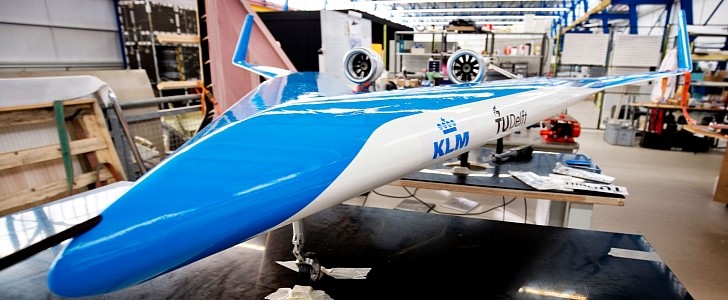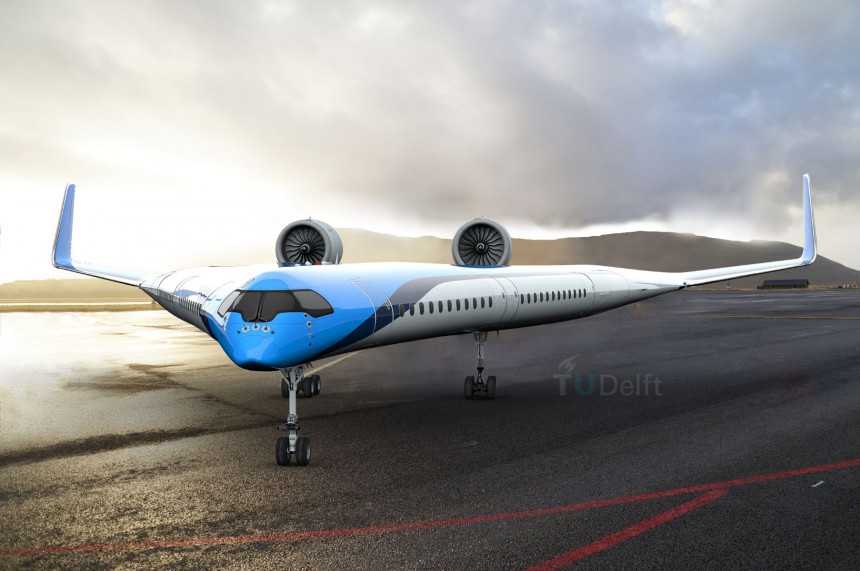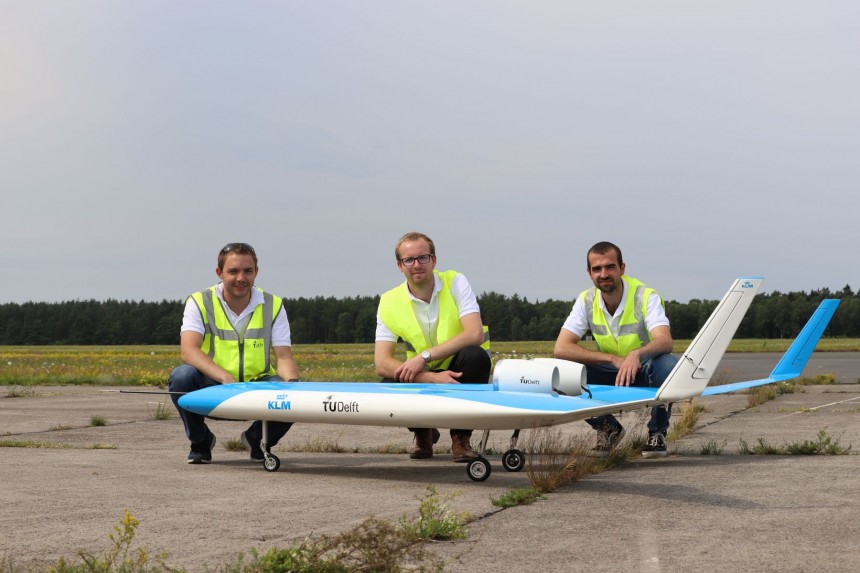A while back we brought to your attention, briefly, a V-shaped plane from KLM and Tudelft. Back then it was just a good looking and sounding idea that was seeming to catch on. Well, now it finally has and testing of this flying structure is officially underway, with a model anyway.
Designed as a thesis project by TU Delft Berlin student Justus Benad, this plane is revolutionizing how we move around in an airplane. Now, the whole V-wing idea isn’t new. The US Airforce Stealth Bombers follow a similar shape. But even more so, nature has been using this structure for millennia. Even birds fly in a V-shape formation as it allows for greater aerodynamic flow through the air, thus using less energy to travel distances.
This is exactly the case here as well. Lets start off with the design. We can see that the main fuselage or cabin of the plane has been moved from the center and into the wings. What this allowed for, is a plane that is shorter than the classic Airbus A350 but has the same wingspan. By moving the cargo hold, fuel tanks, and passenger cabin, the Flying-V is able to offer the same storage space as the A350, and the same number of passengers, 314 altogther.
Such manipulation of space also led to a reduction in weight, giving the design a fuel efficiency 20% that that existing A350. This means that every fifth flight should be free, no? Would be nice, but for an international airline manufacturer, this just means better business while also having less of an impact upon the environment.
Inside, however, it’s a whole different story. The V shape allows for completely new cabin ergonomics. I can sit and explain that there’s room for classic seats, lounge chairs, and even bedding is available within the space. Through the use of lightweight materials, the team is able to reduce the weight of a classic seat by 8.8 pounds (4 kg).
Another beautiful aspect of this design is that it allows for group tables to be set up within the cabin, similar to those on trains. Look, instead of us fillings your day with words, have a look at the videos below and our gallery to better understand of what it is we’re looking at.
About the impact of such a design Dean of TU Delft has this to add, “Ultimately, we have to fly entirely on sustainable energy. CO2-neutral. If CO2 is still released during the flight, for example because we then fly on synthetic kerosene, the same amount of CO2 will be used to produce those fuels. At Delft University of Technology, we are investigating how we are going to achieve this. For example, we are investigating new forms of propulsion, such as electric and electric hybrid, the climate impact of aviation and air traffic operations, such as airports.”
Let’s face it, even though hybrid or fully electric planes, like Alice for example, are making an appearance on the market, they have nowhere near the capabilities of a traditional fossil fuel engine. The maximum number of passengers on Alice is only of nine and two pilots, so we’ll be seeing contrails in our skies for some time to come, even though we ultimately want less polluting flight now.
This is exactly the case here as well. Lets start off with the design. We can see that the main fuselage or cabin of the plane has been moved from the center and into the wings. What this allowed for, is a plane that is shorter than the classic Airbus A350 but has the same wingspan. By moving the cargo hold, fuel tanks, and passenger cabin, the Flying-V is able to offer the same storage space as the A350, and the same number of passengers, 314 altogther.
Inside, however, it’s a whole different story. The V shape allows for completely new cabin ergonomics. I can sit and explain that there’s room for classic seats, lounge chairs, and even bedding is available within the space. Through the use of lightweight materials, the team is able to reduce the weight of a classic seat by 8.8 pounds (4 kg).
Another beautiful aspect of this design is that it allows for group tables to be set up within the cabin, similar to those on trains. Look, instead of us fillings your day with words, have a look at the videos below and our gallery to better understand of what it is we’re looking at.
Let’s face it, even though hybrid or fully electric planes, like Alice for example, are making an appearance on the market, they have nowhere near the capabilities of a traditional fossil fuel engine. The maximum number of passengers on Alice is only of nine and two pilots, so we’ll be seeing contrails in our skies for some time to come, even though we ultimately want less polluting flight now.


























